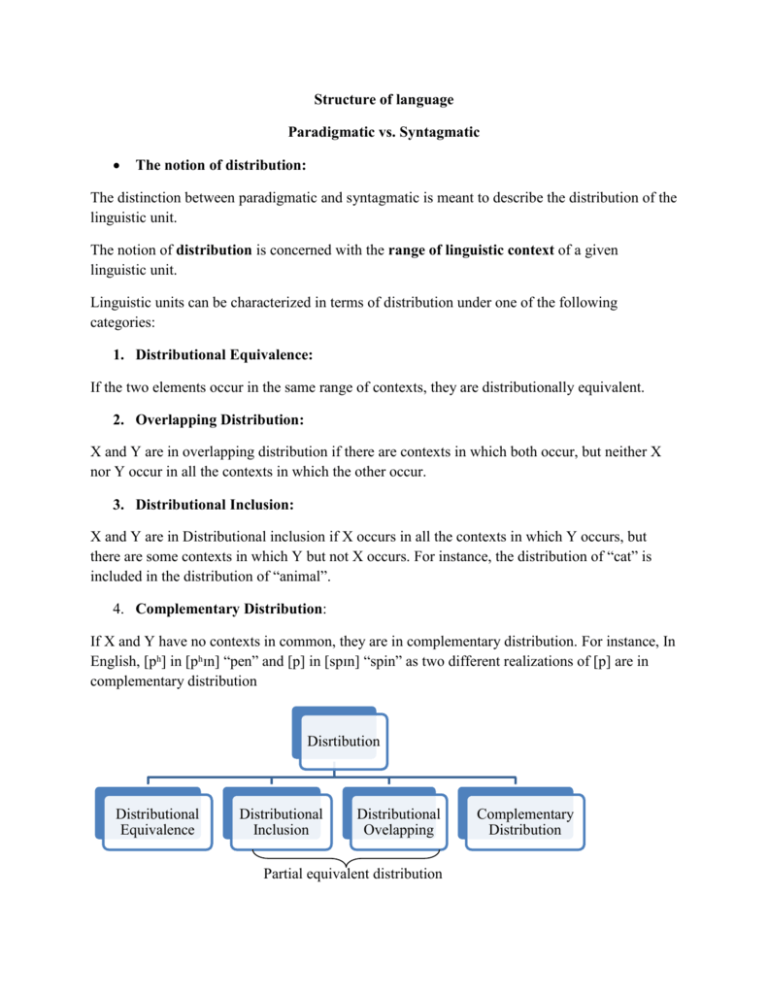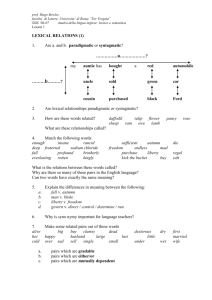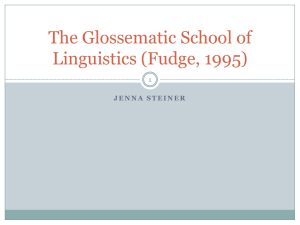Structure of language Paradigmatic vs. Syntagmatic The notion of
advertisement

Structure of language Paradigmatic vs. Syntagmatic The notion of distribution: The distinction between paradigmatic and syntagmatic is meant to describe the distribution of the linguistic unit. The notion of distribution is concerned with the range of linguistic context of a given linguistic unit. Linguistic units can be characterized in terms of distribution under one of the following categories: 1. Distributional Equivalence: If the two elements occur in the same range of contexts, they are distributionally equivalent. 2. Overlapping Distribution: X and Y are in overlapping distribution if there are contexts in which both occur, but neither X nor Y occur in all the contexts in which the other occur. 3. Distributional Inclusion: X and Y are in Distributional inclusion if X occurs in all the contexts in which Y occurs, but there are some contexts in which Y but not X occurs. For instance, the distribution of “cat” is included in the distribution of “animal”. 4. Complementary Distribution: If X and Y have no contexts in common, they are in complementary distribution. For instance, In English, [pʰ] in [pʰɪn] “pen” and [p] in [spɪn] “spin” as two different realizations of [p] are in complementary distribution Disrtibution Distributional Equivalence Distributional Inclusion Distributional Ovelapping Partial equivalent distribution Complementary Distribution The linguistic context is defined in terms of systematic restrictions determining the occurrence of a given linguistic unit. Systematic means that the identity of the context is determined in terms of phonological and grammatical regularities. For instance, /l/ and /r/ in English are in partially equivalent distribution. We have light and right. But we don’t have trip not tlip because it is not accepted phonologically. Besides, we have blend but not brend; brend is phonologically ok, yet it has no meaning and hence no function in English. Free variation: Two linguistic units are in contrast if they are in partially or totally equivalent distribution. Two linguistic units are not in contrast if they are in free variation. In English, [t] and [ɂ] in [bʌtә] and [bʌɂә] “butter” are in free variation. Paradigmatic Vs. Syntagmatic: The potentiality of occurrence of a given linguistic unit in a linguistic unit is determined in terms of paradigmatic and syntagmatic relations. A Linguistic unit is into paradigmatic relation with all the other elements that belong to the same class. This means that elements in paradigmatic relation can occur in the same context. A linguistic unit is into syntagmatic relation with the elements on the same level. Thus, a linguistic unit is in syntagmatic relation with other elements in same context with which it occurs and constitutes the context. It is also termed by Saussure as associative relation. The context of a linguistic unit is specifiable in terms of its syntagmatic realtions; and the range of linguistic contexts in which it is said to occur is determined in terms of it paradigmatic relation with other units belonging to the same class. Paradigmatic ( choice) Syntagmatic (chain) Example 1: In the above example, /b/ as voiced bilabial stop is in paradigmatic relation with units belonging to that same class of “voiced stops” /k,b/. Besides, /b/ is in syntagmatic relation with units at the same level /a,t/.








